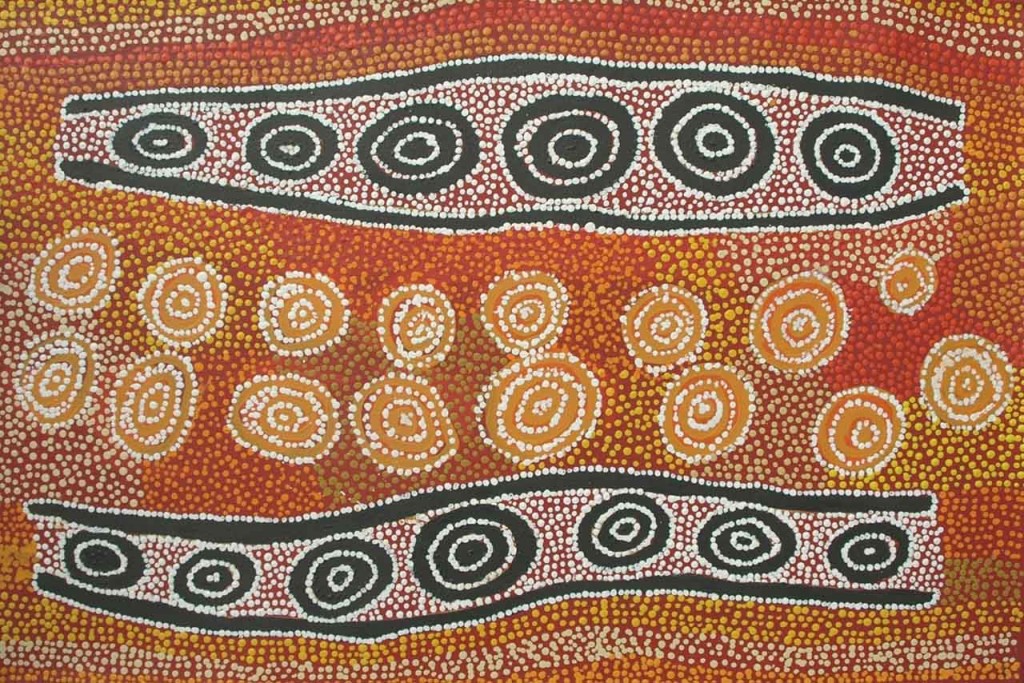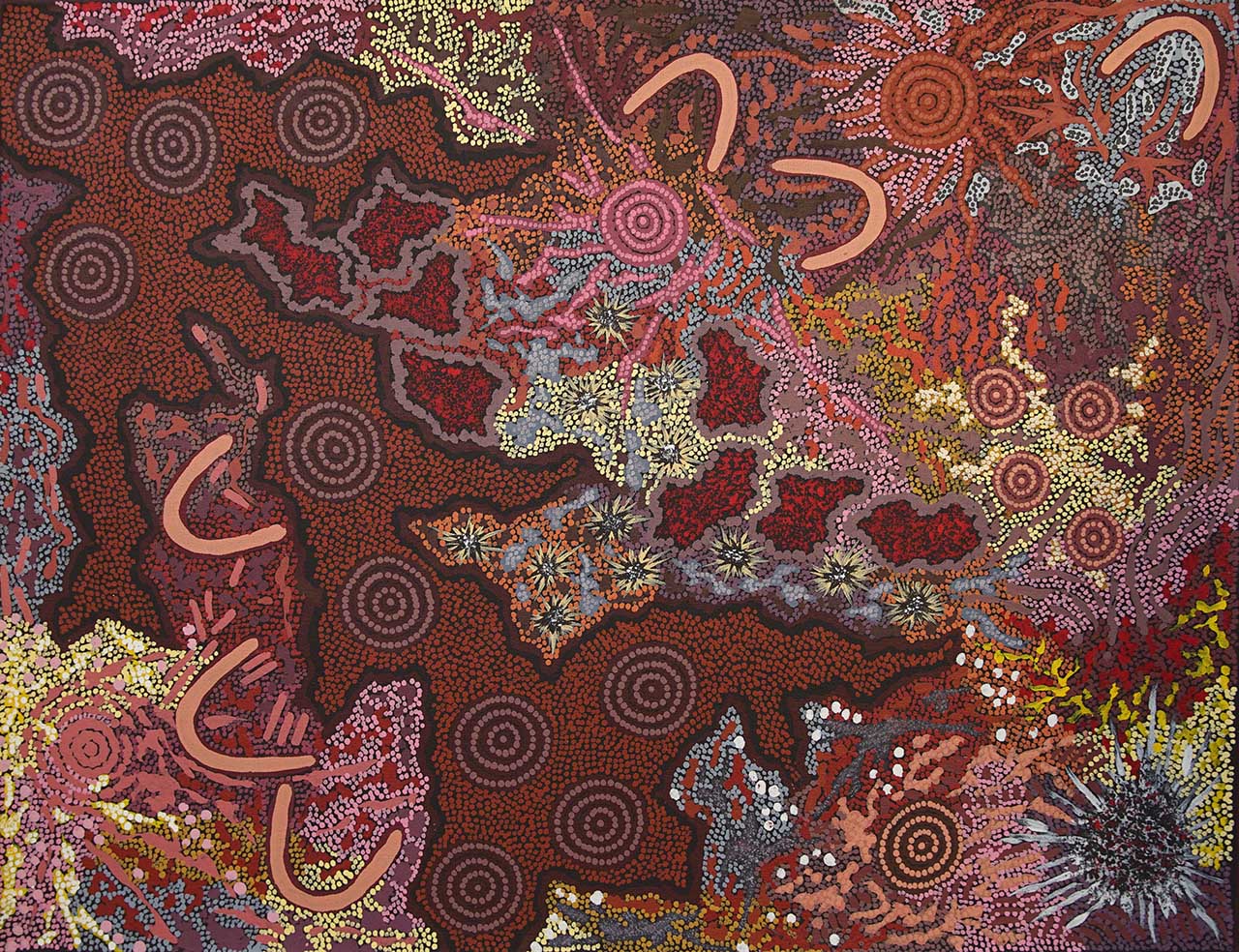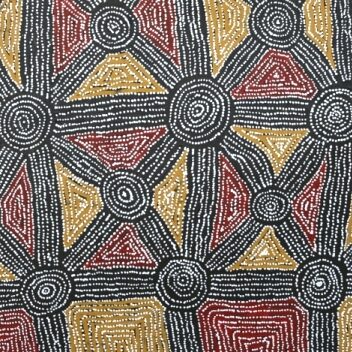The Dreamtime is a term that describes unique stories and beliefs owned and held by different Australian Aboriginal groups. The history of the Dreamtime word and its meanings says something about the development of the ideas held about the Aboriginal world, and how they are expressed through art.
Jukurrpa is one traditional term used by several groups of Central Desert languages to describe what could possibly be seen as the religion and the Laws of the people, and in some ways a description of Reality.
In that sense, traditional Aboriginal people believe that the world was created by Ancestor Beings. The spirit of the Ancestor Beings remains in the country, in the animals and the places and the people of that country as an ongoing presence.
As set in time, the Dreaming - or Jukurrpa in Warlpiri language - is seen as going from the past to the present to the future all at once, so it is something that sits outside ordinary timelines.
When we come to describe much of the content of Aboriginal painting from traditional communities, we are looking at the underlying ideas that arise about Country, ceremony and about people’s connections and obligations to Country.
In many ways these are the defining elements that people recognise in themselves and their own Country, and so when people come to paint about their world and their beliefs, they also connect with their own Dreaming or Jukurrpa stories.
Dreamtime Stories List
Click on any of the Dreamtime stories in the visual list below to read.
Learn More About the Dreamtime
How did the Dreamtime word originate?
The Dreamtime came into being as a word to describe the Aboriginal Creation mythology, and was first used in the 1890s. It was developed from Aranda culture by a white man who was based in Alice Springs and had a very good working knowledge of the local Aboriginal languages.
During the mid 1890s the Dreamtime was popularised in the work of Baldwin Spencer, who was a prominent anthropologist working at the time. The Dreamtime word has since gone into general usage in Australia as a description of the religious beliefs of Aboriginal communities, and has come down through the twentieth century as a widely understood term.
What are the Dreamtime Stories in Aboriginal Art?
When we talk about Aboriginal art, which has been one of the major connection points between Aboriginal culture and Western culture within Australia since the 1970s, we often see reference to Aboriginal Dreamtime as the spiritual ideas or foundation beliefs in Aboriginal culture. But in many ways Dreamtime is not an adequate word.
It’s an English word attached to describe the particular cultural beliefs of the many different Aboriginal groups, and each language group largely has its own words to describe the mythology and the foundation beliefs of the people.
How does the Dreamtime relate to the culture of Aboriginal peoples?
Part of that tradition says that Ancestral Beings created powerful locations that become part of the landscape and that these reflect the power and knowledge of those Ancestors in the locations. Those locations are linked to ceremonies and performances which are tied to family groups. All of that information and knowledge becomes part of an artist’s painting when they’re making reference to their traditional country.
It’s a complex body of Law and religious practice and creation mythology, and an ongoing involvement in life and nature between the people and the Jukurrpa or Dreaming history. It’s a bit like the spirit of Creation is embodied in the landscape and connected to the people, and it is the defining quality by which people recognise their own identity. Their own Country is tied up with the people within the whole complex idea of Dreamtime.
It’s linked with ecology, and it’s linked with people’s obligations and people’s requirements on Country. While people carry those out cultural obligations and continue to be part of that process, they also express those important ideas in their artwork.
Why Are Dreamtime Stories Important in Aboriginal Culture?
Dreamtime is a word that has been in language use for just over 120 years. In the English language it is now well embedded and well understood to represent something about beliefs in Aboriginal culture.
Perhaps it is an inadequate word because it tries to address a complex system of ideas that varies between different Aboriginal communities, and is very hard to express in an English word.
To some extent the idea of Spirit in Country along with the Laws that go with that Country, and the connections with the people who are born into that Country, are all reflected in the concept of Dreamtime. It may be that over the decades we have come to use it most commonly to mean the Creation stories from Aboriginal Australia. However it remains a term that we reach for when we see the powerful essence expressed in some of the significant Aboriginal paintings that we view in museums and art galleries.
It is a deeply complex term that carries a deep meaning for Aboriginal people, and this needs to be duly recognised in the wider Australian community.



